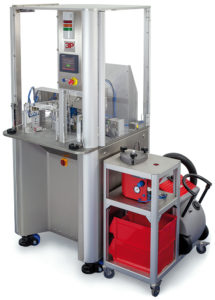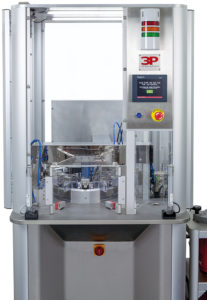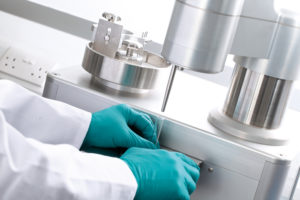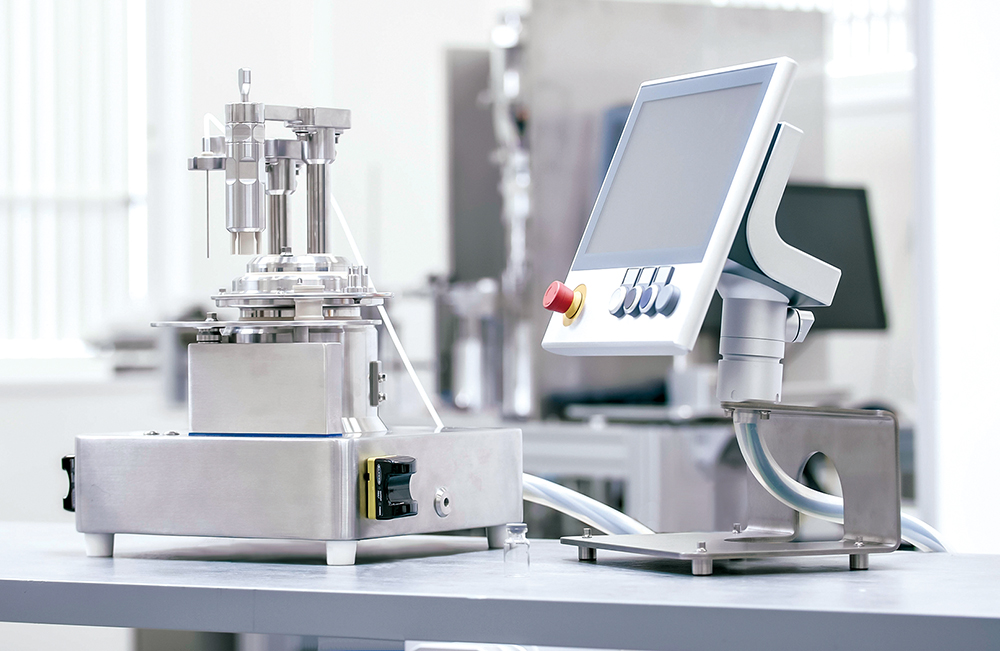To Issue 152
Citation: “Interview with Dave Seaward, 3P: Automating Assembly to Expedite Time-To-Market”. ONdrugDelivery, Issue 152 (Oct 2023), pp 125–128.
Dave Seaward discusses how 3P innovation takes a holistic approach to solving the technical challenges encountered by its clients and looks for opportunities to enhance the final product, enable efficient processing and support commercially viable manufacturing.
“As every automation engineer knows, late-stage machinery changes can be very costly and also lead to significant delays.”
Q What are some of the key manufacturing issues faced by the pharmaceutical industry today?
A One of the key issues in the pharmaceutical industry is scalable assembly. Automating the manufacture of a medical device, such as an injector pen or inhaler, involves handling and assembling multiple plastic components, springs, needles and, ultimately, a primary drug container (usually glass) that’s full of the drug that’s destined for a human being.
When designing and developing such devices, immediately investing in a highspeed piece of automated technology is often unwise. Aside from the fact that new chemical entities often fail during clinical studies, there is also a risk that the device will require changes to ensure that it performs as required. As such, you might well end up with a complex production machine that can’t actually handle the final components. As every automation engineer knows, late-stage machinery changes can be very costly, and can also lead to significant delays.
Q What are the issues faced by small companies developing novel devices?
A Smaller companies trying to develop novel injection devices frequently face the issue of running out of cash before they generate any revenue from their finished products. That’s one of many hurdles we need to help our clients overcome. How do you get representative samples of your device without significant investment in full-scale machinery?
In these situations, people typically attempt to construct a prototype by hand; they put engineers in a cleanroom and get them to tack stuff together. There are two problems with this approach – firstly human beings have a habit of making mistakes, and secondly, they’re also very good at manipulating parts so they go together when, in reality, they would fail in an automated machine. Owing to the nature of the product, any failure in the use of an injector pen is serious; development projects can be derailed by a single failure. Ideally, there should be no debate about whether the failure is attributable to an inherent design flaw, human error during assembly or part tolerances.
Q What is the solution to human error?
A With a machine, you eliminate the human factor. Most devices are put together using a “stack” design. As the name implies, you start with the bottom piece and stack one part on top of another until the top part completes the device assembly. Many of the parts are plastic and will clip together. In automated assembly, you simply apply a linear push force and, if the device is designed correctly, the two parts seamlessly come together.
Q Without automation, what happens during development?
A During this stage, parts are usually assembled by hand. Initially, they might be 3D-printed or are often made from single-cavity moulds without masterbatch (the colourant). They will resemble final parts, but single-cavity parts and masterbatch can create subtle differences compared with multicavity commercial ones. The development parts might clip together successfully when production parts won’t. Even worse, if two plastic parts don’t quite fit together, or if the clips aren’t properly aligned, a person can manipulate the parts until they do assemble. It’s human nature, and it’s a time bomb waiting to derail the project.
These challenges aren’t unique to medical devices. Across multiple industries, we’ve seen the same common engineering solutions work successfully for our clients. These solutions have become a methodologyenshrined within 3P’s DNA – it’s all about process understanding and how you go about obtaining that understanding. Manual assembly is avoided and replaced with simple jigs and fixtures that are “manually assisted”.
Operators load the parts to be assembled into tooling that mimics what you’d find on a production machine. Then, crucially, instead of clipping things together with their hands, the personnel involved are only allowed to pull a handle or move a slide. As such, we’re mimicking a production system, if the plastic components break or don’t clip together when the push force is applied, that’s what would happen in a commercial scale machine and you get early insight that there is a problem. We can also go a step further to gain valuable process understanding – by “mis-setting” the automation in a controlled way, we can start to understand real world tolerance limits for the parts and the automation.

Figure 1: SA3 (semi-automated gluing system).
Q What happens when clients require higher output and/or greater de-risking?
A 3P has what the company calls its semi-auto (SA) systems. The SA3, for example, is a precise, versatile and flexible platform that is designed to automate the assembly of different devices. The tooling and product location features can be easily exchanged to minimise the impact of device changes and the system is easy to adapt, making it ideal for future applications and reuse. The SA3 pallet option also facilitates changeovers – pallets can be loaded offline with components or they can be directly loaded onto pallets fixed in the system (Figure 1).
Q Can you elaborate on the SA3 system?
A What we’ve done within a compact (1 x 0.8 x 2 m) frame is develop a system whereby the operator loads parts onto a rotary table and then – to safely enable manual feeding and fully automatic assembly – they have to keep two buttons depressed. As the turntable rotates, the parts are loaded into the system and that’s when the magic happens. Finished assemblies can be removed and parts loaded by the operator on one side of the turntable while, at the same time, devices are assembled within the machine. This concurrency significantly increases throughput.
With the components at the back, the machine automatically puts the springs, glassware and other components together with a sequence of left-to-right and up-and-down movements. It’s ideal for small, engineering or clinical batch runs of autoinjectors, pens and other medical devices, such as inhalers, and the combination of rapid tooling changeover and keyboard size change means different devices can often be processed on the same machine.
The machine is also bristling with more sensors than you’d normally have in a production machine. This means you get an insight into what’s actually going on during assembly – such as the forces that are generated when parts are clipped together against time – which you don’t normally have, providing a process “fingerprint”. This data-rich environment enables a quality by design approach to device development and, with instrumentation to provide users with real-time graphs and key process parameter trends, the SA3 makes tolerance studies a lot easier. Furthermore, the SA3’s freestanding wheel-in/wheel-out design ensures that it doesn’t take up precious cleanroom space when not in operation.

Figure 2: SA3 close-up.
Q Can you add anything else?
A Production line equipment often incorporates complex motions, generated by either cams or servomotors, which 3P can mimic within the SA3. Preferably, the commercial-scale production machine would be one of ours, but we can simulate any host target plant and our solution is final assembly machine agnostic.
By looking at the S-curves or trapezoidal waveforms that a client’s machine produces, we can analyse that motion, examine the profile and programme that same profile into the SA3; it mimics industry-standard pallet based assembly principles. In practice, as far as the product’s concerned, it’s going through a high-speed machine; in reality, it’s being processed by a low-speed machine that’s mimicking the former (Figure 2).
Plus, as you’d expect from a medtech automation supplier, it’s fully GMP compliant with a validation pack and control system that’s suitable for a 21 CFR 11-based electronic record system. With its engineering expertise, 3P offers a custom build service to cater for specific customer requirements, should they not fit within the normal operating envelope of the system.
“The SA3 provides a cost-effective solution and can run as an autonomous unit – precisely assembling devices, time after time.”
Q Are there any other features you’d like to mention?
A Another useful feature is the ability to “mis-set” the machine in a controlled manner, which allows operators to investigate real-world assembly and part tolerances, create statistical models of the device assembly and run Monte Carlo simulations.
Ultimately, these machines provide small-scale representative batches and de-risk device development. Consequently, the unit can be used to develop the device for ease of assembly and to test the part’s assembly features. Understanding uncertainty and minimising risk early is key to reducing time-to-market, saving money and, if you are backed by venture capital, avoiding the “Valley of Death”. This ensures that optimised product handling parameters can be developed from the outset with the knowledge that the same parameters can then be applied to the scaled-up commercial manufacturing process. One notable example of this methodology, from the fast-moving consumer goods sector, resulted in payback for 3P’s client in less than two months; they eliminated a problem that had dogged their high-speed production lines for decades as a result of insights from 3P’s pilot equipment.
Q Can you explain why this approach saves 3P’s clients costs and provide some examples?
A The cost of providing devices for small-scale clinical trials can be significant because the volumes do not justify commercial equipment and production processes. Equally, manual assembly systems suffer from human error and, as discussed earlier, they can also lead to successful assembly from defective parts. The SA3 provides a cost-effective solution and can run as an autonomous unit – precisely assembling devices, time after time – thereby decreasing variability and lowering the costs associated with producing clinical batches.

Figure 3: LAB dosator close-up.
This methodology runs deep in the 3P psyche, with many successful examples. The Lab Dosator was designed in response to a client request and our process understanding mindset. Now part of our Pharma Equipment Discover range, it fully replicates commercial dosator-based powder dispensing at a laboratory scale. Where did it come from? A client told us that they had a system with 72 dosators that was suffering from an unacceptable frequency of dosator seizure. Initially, we were asked to source a full set of dosators with a “tweak” to the design in an attempt to solve the issue.
Instead of trying to develop a solution on the commercial equipment with 72 dosators, 3P recommended construction of a small instrumented simulator with a single dosator. What we did was examine the existing system, modelled it and then produced a single-head prototype. Again, we applied more sensors than usual to assess the forces working within the unit and the tolerances that needed to be managed (Figure 3).
The insights from the data meant that we were able to optimise the dimensions and parameters with just a few iterations. We then produced a set of 72 and fitted them successfully on the production machine. As a laboratory-scale device, this dosator fits within small fume enclosures and operates with a very small powder bed. This is critical in the early stages of formulation and process development when active ingredients for testing may be scarce.
Some of the Lab Dosator’s significant benefits include its inherent flexibility and ability to replicate commercial processes. It can fill medical devices, inhalers, capsules or blisters under controlled laboratory conditions, and dispenses consistent samples directly into delivery units for clinical or pharmaceutical evaluation. It is primarily used as a formulation screening tool.
Q Could you give us an insight into 3P’s fill-finish process?
A The same methodology has been used in the fill-finish of vials and cartridges that are typically used in high value parenteral applications or cell and gene therapies. 3P repackaged fill-finish technology from our larger tub-based isolators into the Discovery range’s Fill to Volume (F2V) compact fill-finish system and associated crimper (F2C). Cell and gene products typically rely on highly skilled technical staff to pipette products within a biosafety cabinet. What if the risk of error from the technical staff could be eliminated with a miniature and sensor rich fill-finish system that could fit within a biosafety cabinet? Sound familiar? 3P’s Liquid F2V is an isolator-ready, flexible platform for both filling and finishing a wide variety of containers and devices, including syringes, cartridges, vials, bottles and customised primary drug containers.
Whereas most lab-scale systems only offer individual process stations, F2V provides a GMP-compliant, all-in-one integrated system for nitrogen purging, liquid filling, vacuum stoppering and other processes on the same machine. This increased level of automation improves productivity, product quality and patient safety, while still providing the flexibility you would expect from a low-volume benchtop system. Operators are not required to transfer containers between the critical fill and stoppering processes, thereby simplifying the process and reducing risk. Using the same principle, 3P used sensors that wouldn’t normally be seen in a production system to provide operational feedback and made it benchtop scale (Figure 4).

Figure 4: F2V (liquid fill-finish platform).
Q Are there any final thoughts you’d like to share?
A If you look at an SA3 next to a Lab Dosator or an F2V/F2C, you would be hard pressed to recognise any obvious similarities – other than the 3P logo. To 3P engineers, however, they all offer clients a way to reduce technical risks through process understanding. They share a common 3P heritage of successfully developing robust automation. The take-home message here is that the concept of using sensor-rich pilot equipment that mimics commercial-scale systems – which is a fundamental part of 3P’s modus operandi – has been successfully used to develop systems specifically for the inhalation space, powder dispensing and, more recently, vial and cryovial filling. Perhaps the only question remaining, therefore, is what comes next?
Find out more about 3P innovation by visiting: www.3pinnovation.com.

